Pruning Apple and Other Fruit Trees
Posted on Monday, March 20, 2023 · Leave a Comment
Ask a farmer, “When should I prune my apple trees?” and you will most likely hear, “March.” That’s an old tradition – but not because it is the only time to prune. You can prune any time. But March is a month on a farm when not so much is happening outdoors, and farmers have time to prune their apples. Me? I often prune in the fall, or later in the spring when the ground dries out and it warms up. I say, “Prune when you have the time and inclination.”
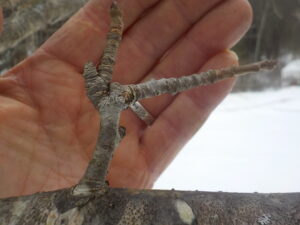
Fruit spur on an apple tree will produce fruit and leaves
Pruning serves a number of functions. First, for many of us, it helps to create a work of living sculpture. Most of us don’t need as many apples or peaches as healthy tree will produce. But we do enjoy seeing a well-balanced, aesthetically pleasing tree every day of the year, especially in winter.
Next, pruning opens up a tree and lets sunshine hit every leaf so that it can produce food for the roots and fruits. A well-pruned tree will be healthier and produced tastier fruit than a neglected tree. My pruning mentor told me decades ago that a bird should be able to fly through a well-pruned apple tree without getting hurt.
When pruning a fruit tree it’s important to know which branches will be blossoming and producing fruit. Look for fruit spurs on apples and pears. These are roughly 3- to 6-inches long protuberances with buds on them. As you prune you will have to make choices about which of two branches to cut. Look for those fruit spurs, and be guided by them.
In general when making cuts on an older, neglected tree, it’s better to remove a few larger branches than trying to make many, many smaller cuts.
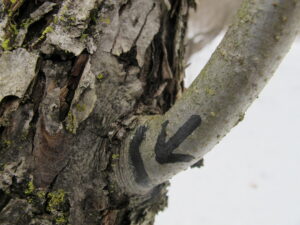
Branch collar and line to show where to cut
It’s important to know where to make your cuts. If you cut off a branch flush with the trunk you will create a bigger wound than if you cut it off a little farther out from the trunk. Notice that most branches swell a bit at their base. That swollen, wrinkled area is called the branch collar, and it is where healing takes place. Cut just beyond the collar. But if you cut too far out the branch, you leave a stub which will not heal quickly – it will have to rot back to the collar before it can scab over.
Start by removing any dead or damaged branches. Cut them back to the trunk, or to a larger branch where they originate. Heavy wet snow and high winds this winter have created lots of broken branches. Clean them up. Knowing if a small branch is alive is easy: scrape it with your thumbnail. If it show green, it is alive. Bigger dead branches will have flaky, discolored bark and will not be flexible if bent.
Remove any branches that are rubbing other branches. Keep the best looking branch and remove the other. Remove any branch that is headed into the center of the tree instead of growing towards the outside.
Or perhaps you’d like to begin with the easiest branches to remove, the water sprouts. These are vertical shoots coming up from a more-or-less horizontal branch. They are very numerous in some trees, not so much in others.
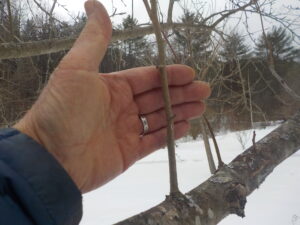
Water sprouts need to be removed yearly
Water sprouts are generally a tree’s response to a need for more food for the roots. Trees that haven’t been pruned in years have many of these as there are many leaves shaded out and not producing much food for the roots. Or after a heavy pruning, a tree may produce lots of water sprouts to replace food-producing branches that have been removed.
If water sprouts are not removed when the thickness of a pencil or a hot dog, they will become as thick as your arm or leg and be difficult to remove. So clean those up every year.
You can change the angle of growth of a branch that is only an inch or less thick. Once winter is over, attach string or rope to a branch and tie it to a peg in the ground or to a weight to bend it down. A half-gallon milk jug works well. Just add water until you have the correct angle on the branch. Forty-five to sixty degrees off vertical is fine. You can remove the weights in June. Branches that are 45 degrees from the horizontal produce more fruit than more vertical branches.
If you have to remove a bigger branch, do it in two steps. First make a cut two or three feet out from the trunk to reduce the weight of the branch. Then make a second cut just outside the branch collar. Use one hand on the saw, one hand supporting the weight of the branch. That will prevent tearing the bark on the trunk if it falls before you finish the cut.
When pruning, don’t overdo it. Trees need their leaves to feed the roots and fruit. In any given year don’t take more than 25% of the leaves (woody stems don’t count when calculating how much you have taken off). In winter you just have to estimate how much live wood you can take off.
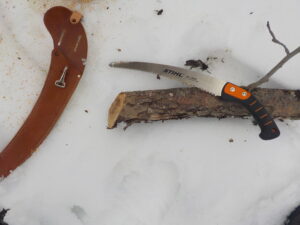
This pruning saw made short work of removing this bigger branch
A few words on tools: The basics are a good pair of hand pruners, kept sharp. A good pair of geared loppers for medium-sized branches. A good hand saw with a tri-cut blade for branches bigger than an inch or so. Don’t buy the cheapest you can find. Buy the most expensive you can afford. My new curved Stihl hand saw went through a 3-inch apple branch like a hot knife through butter. With the leather sheath, it cost about $65 and is worth every penny.
Pruning is fun. And if you make a mistake, don’t worry. Your tree will grow a new branch to replace the one you removed.
Plan to Plant Plenty of Annual Flowers
Posted on Tuesday, March 7, 2023 · Leave a Comment
Reclining in an easy chair on a recent cold and snowy day, I imagined myself a bumblebee. I meandered from flower to flower, taking in the colors and scents and textures of annual flowers, starting with A (alyssum) and ending with Z (zinnias).
I wasn’t a good or careful bumblebee who only visited flowers of one kind: I was a bumblebee tourist, seeing everything my mind could imagine – and all were in bloom at once. Then, returning to reality, I got out of my catalogs and started searching for new flowers to try.
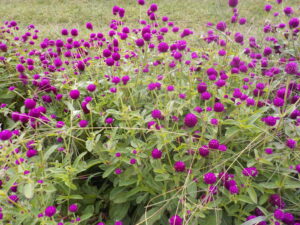
Gomphrena is great fresh or as a dried flower
Annual flowers are wonderful. Perennials are great, too, but most make a relatively short appearance, rarely more than three weeks . Annuals are born to flower: many start early and keep on blooming all summer if you keep cutting them. They need to make plenty of seeds or their genetic lineage can literally die out and disappear at the end of the season.
I like starting annuals by seed in 6-packs indoors, even when it’s warm enough that I could plant them directly in the ground. Flowers can easily get lost or misidentified as weeds when planted directly in the soil, especially things I haven’t tried before, or if I just want a few.
I love zinnias. They come in such a profusion of colors, and range in size from diminutive to giant. I love the lime-green ones such as Envy and Benary’s Giant Lime because they look so great mixed in with other flowers – in a vase, or in a flowerbed. Zinnias come as singles, such as the Profusion series, which are short (12”), and doubles such as Sunbow (24-30”) and Oklahoma (30-40”). I save seed from non-hybrid ones and plant them directly in the soil in large numbers. And the more you cut these flowers, the more they branch and re-bloom.
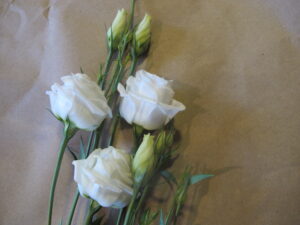
Lisianthus comes in several colors and lasts well
Most annual flowers are easy to grow from seed, but not all. One of my favorites, Lisianthus, takes 17 days to germinate if kept at 72 degrees, longer if cooler. And even after it starts to grow, its seedlings do not grow fast for several weeks. It’s not a flower for impatient gardeners.
Cosmos varieties have been bred and hybridized in recent years. Looking at the John Scheepers Garden Seeds website I see 23 different kinds of cosmos, including one I must try: “Double Click Cranberries Cosmos”. Deep wine colored, double-petaled like an old fashioned rose.
A flower good as a cut flower or as a dry flower and spectacular in the garden goes by the unlikely name gomphrena. I plan to plant at least a dozen of these this year, maybe more.
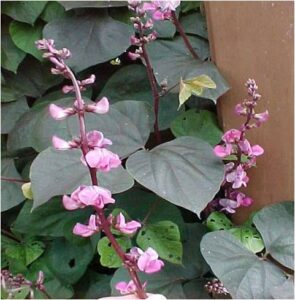
Purple Hyacinth Bean has both lovely flowers and interesting foliage
Vines are good, too. I love purple hyacinth bean with purplish leaves and pink-purple flowers. They are slow to start, so I’ll start some indoors in March.
Nasturtiums are vines that don’t climb. They sprawl. Plant these large seeds in full sun after the danger of frost has past, perhaps in a bed of daffodils. The daffies need sunshine to recharge their bulbs until the foliage dies away, and the nasturtiums will fill in and hide the dying foliage. Nasturtiums like lean soil, so don’t add fertilizer.
I grow some of my favorite annuals not for their flowers, but for their leaves. These beauties are always in bloom – which is to say, their leaves are a treat to look at. I love their bright colors and shiny surfaces. Here are some good ones:
Perilla: This is a terrific purple-leafed plant that self-sows exuberantly. Pinch off the flowers (which are not at all showy) if you don’t want it to spread next year. Eighteen inches tall. The ‘Magellanica’ cultivar is taller, and has foliage in shades of hot pink, deep plum and vibrant green.
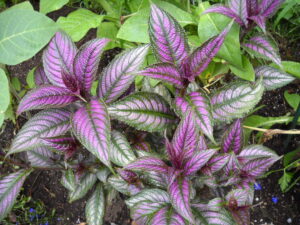
I grow Persian shield for its foliage
Persian Shield (Strobilanthes dyerianus): This plant just shimmers with silver overtones on dark purple and pink leaves. It loves hot weather, and gets big: one plant can spread over a 3-foot circle and stand 3-4 feet tall.
Licorice Plant (Helichrysum petiolare): I buy some of this every summer because I love the silvery leaves, because it mixes so well with bright colored flowers in planters, and because it takes abuse. It rarely complains if I let it dry out in a pot. It flows over the edge of pots and weaves it way through other plants. It’s also an exceptional in flower arrangements. There are also chartreuse and variegated lemon-lime varieties.
So even though annuals are disposable plants – they die when frost comes – I have to have them. I grow them in the vegetable garden, and in pots to fill in drab corners of the flower garden after perennials have finished blooming. If you want, all those mentioned above are available as plants in six-packs at your local nursery, come spring. Most are great cut flowers – and the bumblebees love them.
Reach Henry Homeyer by e-mail at
henry.homeyer@comcast.net or by mail at PO Box 364, Cornish Flat, NH 03746. He is a UNH master
Gardener and the author of 4
gardening books.
Get Ready to Start Seedlings Indoors
Posted on Tuesday, February 28, 2023 · Leave a Comment
Starting seeds indoors under lights is a good treatment for the winter blues. It connects me to my upcoming garden and all its benefits. Early March is when I start onions and peppers, though April is the month for most everything else.
My wife, Cindy Heath, and I are making a commitment to reduce/eliminate the use of plastics in our life, so we are transitioning away from those handy, dandy flimsy plastic 6-packs for starting seeds. You can, too.

Metal planting cells from Gardeners Supply
Gardeners Supply Company has been offering ways of reducing single-use plastics like those 6-packs sold everywhere. They have sturdy reusable plastic trays for seed starting which have been available for a few years. This year they came out with metal seed starting trays.
These galvanized steel growing cells are pricey, but should last a lifetime. For about $50 you get 24 individual, tapered cells and a leak-proof tray to hold them. The cells are a nice big size. The kit is self-watering: it comes with a wire grid and moisture-retaining mat that keeps seedlings hydrated from the bottom of the tray which you fill with water once a week or so. I got one of these kits and looks like a winner.
Renee’s Garden is now selling seed starting cell trays made of silicone that are sturdy and reusable, and dishwasher safe. They do not get brittle, they say. I am ordering some to try them.
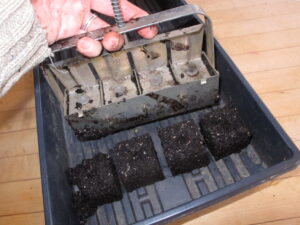
Making soil blocks with a simple press
If you don’t mind extra work and lots of mess, you can make soil blocks using a little metal press that produces 2-inch soil blocks. The mixture includes peat humus, compost, soil, blood meal and minerals. E-mail me for more info about the process.
So what else do you need? Lights, growing medium and seeds. Let’s start with lights. To keep your light bill low, I recommend using LED lights. I have some old-fashioned 4-foot fluorescent lights, but have been replacing them with the LED equivalent. These look about the same, but have no ballast (transformer) inside the fixture and use much less electricity.
If you replace your old fixtures, don’t just throw the old tubes into the trash as they contain mercury, which is toxic waste. Some recycling centers will accept them, or bring them to an electrical supply company for proper disposal. And if you want to use an LED tube in an old fluorescent fixture, you should remove the ballast. Unless it says “No PCBs on it, it needs to be sent to a hazardous waste collection site also.
Hang your fixture about 6-inches over the planting trays. Use “jack chain”, a small-link chain sold at hardware stores. It allows you to raise the lights as your plants grow. Give your seedlings 12 to 14 hours of light per day – they need a good night’s sleep as much as you do.
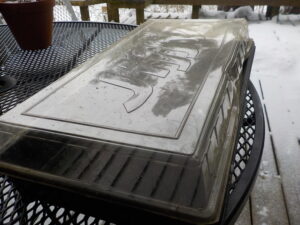
Plastic caps keep seeds from drying out
Most seeds will wake up and grow more readily if you place them on a warm base. Electrical seed-starting mats are great for that, but not really necessary. I use them for things that specify warmer temperatures, like the flower Lisianthus, and for hot peppers.
I recommend buying “Seed Starting Mix” instead of “Potting Soil” to put in your planting cells. Why? Seed starting mix is a finer blend and works better. It is made from peat moss, vermiculite, perlite and fertilizer. You can make your own, of course, and I often do – I start 10 flats (trays) or more each year. I also mix in some high quality compost – about 50% of the final product. I also add a little Pro-Gro, a slow-release organic bagged fertilizer.
Peat moss is coming under criticism now by the eco-minded community. It is harvested from bogs and is centuries in the making. Coir, a palm fiber, is becoming more available, but I haven’t found it yet in big bags like peat moss.
Moisture is key for starting seeds. If the soil mix dries out before they get well established, they can quickly perish. That’s okay with me – I need a reason to get out of bed on gray days in mud season. Gotta check my seedlings and give ‘em a drink after I have my coffee!
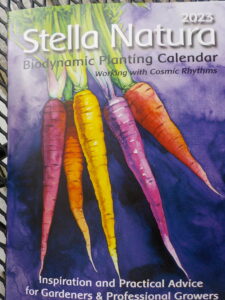
The Stella Nataura calendar gives planting times based on celestial rhythms
You can contain moisture by buying and using clear plastic covers for your flats of seedlings. They are inexpensive and reusable. Take them off after everything has germinated, or most things.
A biodynamic calendar called Stella Natura is available for gardeners who want to plant seeds by the phase of the moon, stars and planets. I consult it when planting, and although not foolproof, I think it helps. Available at
www.stellanatura.com.
So if you want another hobby, grow your own plants from seed. It takes a little practice, but it may make you happy – it works for me!
Henry lives in Cornish, NH. He regularly gives gardening talks at garden clubs and libraries. Reach him by email at
henry.homeyer@comcast.net.
Tips for Buying and Enjoying Cut Flowers
Posted on Tuesday, February 21, 2023 · Leave a Comment
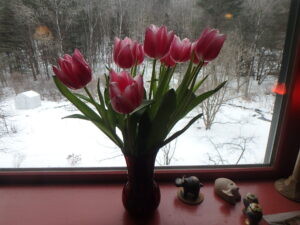
Tulips brighten a winter day
Winter drags on, even though the days are getting longer. The sun is often lurking behind gray clouds, and on a good day we only get about 9 hours of light. I do miss the colors of summer, so I keep fresh cut flowers on our table – even though I have to buy them.
Cut flowers are among modern America’s true bargains. For the price of a bottle of wine – or a couple of cups of fancy coffee – you can buy flowers that will grace your table for up to three weeks. But there are some things you should know about getting good table-life for your investment.
First, you need to buy fresh flowers that have been carefully tended – and you can’t beat a florist for that. A floral shop has trained personnel who trim each stem in the store every other day and change the water to keep flowers fresh. Cut flowers need to take up water to stay fresh and healthy. Stems tend to scab over after a day or two, which means they cannot take up replacement water, or not much, so they suffer.
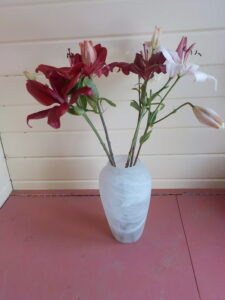
Ask for locally grown flowers like these Asiatic lilies I bought recently
Here are some things you can do to promote longer vase life: cut off leaves that would enter the water in your vase. Leaves will rot, promoting growth of bacteria, which will impede water take-up. Cut off half to three quarters of an inch of each stem every few days, and change the water. Use the packets of white powder that often comes with flowers – it does help.
Keep your arrangement cool if you can. Putting it near a radiator or woodstove, or putting it in a sunny window will shorten its life. If you have invested in pricey roses or tulips, you may wish to move the vase to the entryway or mudroom at bedtime to keep the flowers extra cool during the night.
Some flowers are better picks than others if you’re on a budget and can’t afford to buy new flowers every week. Here are my recommendations for good cut flowers:
- Lisianthus: These look like silk flowers to me: perfect white, pink or lavender-colored bell-shaped flowers on long stems. Tough to grow in the garden, they are perfect in a vase – I’ve kept them for up to 3 weeks.
- Miniature carnations: Each stem has 2-4 blossoms. They come in a variety of colors. Mix dark red “minis” with red roses to make a bouquet of roses look fuller. And even after the roses go to Valhalla, the carnations will still be good!
- Chrysanthemums: These come in a variety of sizes and colors, from the huge spider mums to little guys. I love the scent of the flowers –it’s not overpowering, but it’s there if you sniff them.
- Statice. I grow these for use as dry flowers, which tells you that they really do last forever – even out of water. They come in blue, purple, pink and white.
-
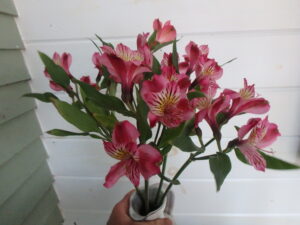
Alstromeria is a long lasting inexpensive cut flower
Spray roses: Instead of a single blossom per stem, these have 2-5 blossoms, giving you more bang for your buck. These will last about a week – or even more with proper care
- Alstromeria: One of the best for long life. Each long stem has clusters of 2-inch lily-like blossoms in pinks and reds, with yellow throats. If you buy them in bud, they will look good for three weeks!
- Orchids: While not cheap, orchids as cut flowers can last up to a month. I love dendrobiums, though they are not common, even in floral shops. Cymbidiums have bigger blossoms and also last extremely well.
- Kangaroo paws: These Australian natives are fuzzy and cute. They come in pinks, reds, orange and brown, and last very well. Not every florist will have them.
- Asiatic lilies: I recently got a bouquet of five nice stems grown in New Hampshire that was sold at my local Coop food store. For $12.95, they will bloom with great elegance.
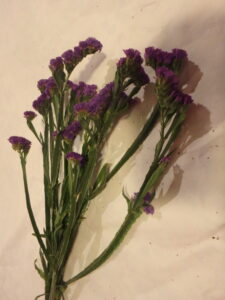
Statice is a good flower for drying and will last for months
You may wish to ask where the flowers you plan to buy are from. Holland, Columbia, Ecuador and Kenya are the world’s top growers and export much of what is available. Some foreign growers have been criticized for producing flowers using strong pesticides and poor labor practices. The Sun Valley group in California is an excellent major American grower of cut flowers – but there is still the environmental cost of shipping them 3,000 miles to us. If you can buy flowers grown locally in greenhouses, do it!
Everyone loves to receive the gift of cut flowers, even us guys. So treat your loved one – or yourself- to fresh flowers this winter. They’re cheerful, and can make winter less oppressive for gardeners.
Henry lives in Cornish Flat, NH, He is a
gardening consultant and a presenter of
garden talks with slide shows for clubs and library groups, both live and via Zoom. His email is
henry.homeyer@comcast.net.
The Benefits of Organic vs Chemical Soil Treatment
Posted on Tuesday, February 14, 2023 · Leave a Comment
On a cold and snowy day I paused to think back a few years to a conference I attended run by the Ecological Farming Association in Pacific Grove, California. There were several sessions by scientists presenting research confirming what organic gardeners have always known: organic techniques yield plants that resist disease and insects better, and produce better quality and healthier vegetables. There was even data presented indicating that organic practices can reduce weed pressure! I dug out my notes, and would like to share some of what I learned.
Dr Larry Phelan, a research scientist at Ohio State University, explained that he wanted to see if organically grown plants attracted insect pests differently than those grown using conventional techniques. He collected soil from two farms that were across the road from each other. The soils were identical except for how they had been tended for the past several years. One farm was organic, the other conventional.
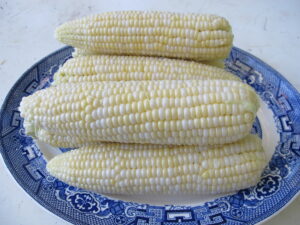
Organic corn from my garden never gets treated with chemicals
To reduce other variables, Dr Phelan brought the soil to his greenhouse, and potted it up in large containers. He then grew corn in containers, adding chemical fertilizers in some, fresh cow manure in some, and composted manure in others, using both types of soil for each method. When the corn was at the appropriate size, he released corn borers into the greenhouse, and watched what happened.
Not surprisingly, the corn borers preferred the corn grown conventionally. Not only that, the long term history of the soil mattered. The soil from the organic farm had higher levels of organic material in it, and consistently was less attractive to the borers – even if used with chemical fertilizers.
Why should this occur? Dr Phelan explained that plants evolved over the millennia getting their nutrients through the soil food web, depending on the symbiotic relationships between plants and microorganisms. Chemical fertilizers are imprecise, providing nitrogen for fast growth, but often giving too much nitrogen, or providing it all at once. Soils rich in organic matter provide nitrogen and other needed nutrients in a slow, steady stream – the way Mother Nature does it.
He said that when a plant gets too much nitrogen, the excess is stored in the form amino acids, the building blocks of protein. For insects, this is like candy for kids or drugs for addicts: they can detect it, and go to the source.
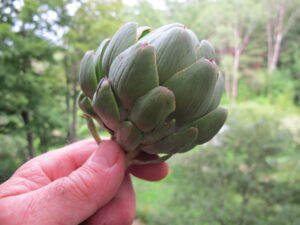
This artichoke from my garden was grown without chemicals
In another experiment, Dr. Phelan grew soy beans hydroponically, varying the amount of nutrients present. The soy bean loopers preferred plants that were out of balance nutritionally. But not just nitrogen mattered. Iron, boron and zinc levels were important, too. And of course, those elements are not present in conventional fertilizers. Chemical fertilizers only offer nitrogen, phosphorus and potassium. Good soil enriched with compost should have everything your plants need.
Dr. Autar Mattoo of the United States Department of Agriculture Research Station in Beltsville, Md., also presented some very interesting findings. He compared the health of tomatoes grown with chemical fertilizer on black plastic versus that grown organically using a mulch of hairy vetch, an annual cover crop. He found that tomatoes grown with hairy vetch was dramatically better at resisting fungal diseases, especially those that cause blackening and dropping of leaves, which is often the bane of gardeners.
Dr. Mattoo explained that the vetch fixes nitrogen when growing. Which is to say, it extracts nitrogen from the air and turns it into a form that plants can use. It was mowed down before flowering and allowed to stay on the surface of the soil, producing a considerable biomass to nourish soil microorganisms.
Compared to chemical fertilizer and black plastic, Dr. Mattoo found a 25-30% increase in yield using vetch. He explained that eventually the organic tomato plants would develop fungal diseases, but that for the first 84 days after transplant (late August for us), there was virtually no leaf blackening. At the same time, the tomato plants grown conventionally were severely damaged.
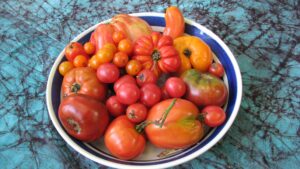
A selection of my homegrown tomatoes
He attributed much of the difference to hormone signaling. Anti-fungal proteins can be produced when specific genes are activated, protecting leaves. He explained that depending on the environmental conditions specific genes are turned on or off. He was able to show this by photographing specific genes in the leaves of the tomatoes to see their size and thus their levels of activity. It appears that something in the vetch stimulated the tomatoes to produce those anti-fungal proteins.
What does all this prove? Being an organic gardener has many benefits, and scientists are just catching up with us! So as you plan your garden projects for the spring, think about giving up your use of chemical fertilizers. There are plenty of organic fertilizers made from natural, biologically-created ingredients like oyster shells, peanut hulls, cotton seed meal and naturally occurring minerals like rock phosphate and green sand. And of course, compost is a terrific way to increase biological activity in your soil.
Many thanks to all you readers who have donated to support Notes from the Garden. If you have been enjoying the column, learning from it and wish to donate, please go to my website,
www.Gardening-Guy.com and go to store/donations and follow the prompts. Or do it the old fashioned way, and mail a check to Henry Homeyer, PO Box 364, Cornish Flat, NH 03746.
Building a Simple Plant Stand
Posted on Tuesday, February 7, 2023 · Leave a Comment
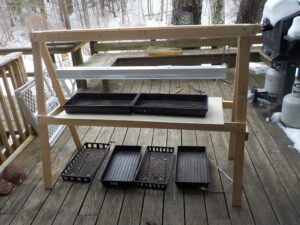
The finished plant stand
As I write this, the wind chill factor is well below zero, and summer seems a lifetime away. But if you are thinking about starting seeds indoors this year, this would be a good time to build a simple wooden plant stand. You don’t have to be a carpenter to build this, or to have expensive power tools. Your local lumber yard will cut the pieces you need.
Mine is a simple A-frame, with one shelf, and the space for more plant flats on the floor. It stands about 4 feet tall, is 5 feet wide from end to end, and 2 feet from front to back at the base. It has space for 4 or 5 flats or trays, each of which will hold at least 32 plants – more if you buy the smaller six-packs that I avoid (some flats can hold 48-72 plants). And if at a later time you want to grow more plants, you can put another four flats or more on the floor and add lights above them.
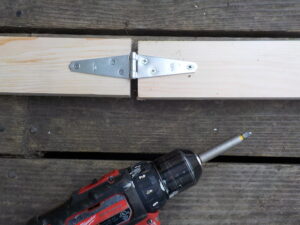
Install the hinges on the 4-foot leg pieces
The lumber for this cost me about $50 and the light fixture – a simple shop light with 2 four-foot LED bulbs and a plug-in cord – cost $62, although often they are more expensive. Looking at catalogs, I see that one can easily spend much more for a pre-made plant stand. If you decide you like starting plants in the house, you could buy the extra lights next to illuminate more flats on the floor.
Here is what you need to buy for the model I built:
(4) pieces of 1”x3” pine, 4 ft long
(4) pieces of !”x3” pine, 5 ft long
(2) pieces of 1×3 pine16” long for cross bracing
(1) piece ¼” plywood, 18”x4’ (you can use thicker plywood if you have some)
(1) pair 3” strap hinges
4-feet of quarter inch jack chain for hanging the lights and 2 small cup hooks to hang the chain.
(1) 4′ shop light with LED bulb and a plug-in cord
(30) sheet rock screws (1.25” long)
Tools: portable drill with magnetic bit to fit the screws and a measuring tape
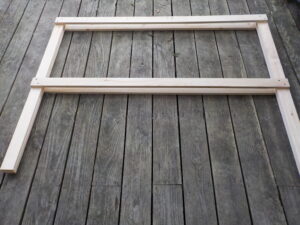
Screw in the 5-foot cross pieces
Most lumber yards will cut all your materials to size for you, but do not have small sheets of plywood. I found that Home Depot does have plywood in 2-foot by 4-foot sheets, and they cut mine to give me a piece 18” by 4’ for the shelf. You will need to ask them to cut the 1×3 pine boards as follows: four 60-inch pieces, four 48-inch pieces, and two 16”pieces.
Start by making 2 legs for your plant stand. Lay the 4-ft pieces end-to-end on the floor. Do it on your deck if possible, or next to a wall so that you can get them in a straight line by lining them up with something that is straight. Lay the hinges in place so that you will be able to fold them closed (most hinges only close one way). A cordless drill with a magnetic bit for Phillips screws will make your work much easier. To start the small screws on the hinges, make a hole first with a nail or awl, or a tiny drill bit.
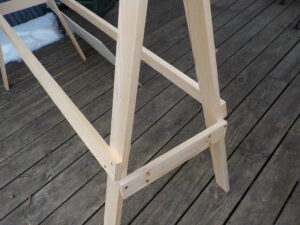
The cross braces add stability
Next close up the hinged legs and place them 5-ft apart on the floor. Place 2 of the 5-ft pieces on top of the first side. One should be screwed right at the top, one 24 inches from that. Flip over the stand, and do the same on that side. Stand it up, and spread the legs 2 feet apart at the bottom. Then add a cross brace on each end of the A-frame just below support pieces for your shelves.
Lastly you need to hang the light. Mine came with S-hooks and chain, which made hanging the lights easy. If yours do not, you will have to buy them. Most shop lights have slots and holes on the back side so that you can slip in S-hooks easily to hang it. You can also open a link of your jack chain and fit it in without an S-hook, just use 2 pairs of pliers to bend a link open. Screw 2 small cup hooks into a top cross piece and attach the jack chain. The chain will allow you to raise or lower the light – lights should be about 6 inches above the plants.
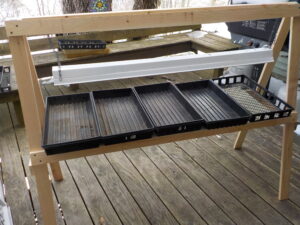
The shelf will hold 4 or 5 flats of seedlings
Starting seedlings indoors is miraculous for me – even after doing it for decades. I hold my breath waiting for germination, and fuss over the seedlings like a mother hen. And when I bite into my first tomato in August, I have the added satisfaction in knowing I brought that tomato into my world – with lots of help from Mother Nature.
Henry is the author of 4
gardening books. Reach him at PO Box 364, Cornish Flat, NH or by email at
henry.homeyer@comcast.net.
Saving Seeds from Heirloom Vegetables
Posted on Tuesday, January 31, 2023 · Leave a Comment
As a boy in the 1950’s I knew there were two kinds of tomatoes: deep red, plump and tasty ones my grandfather grew, and the kind that came four in a package wrapped in cellophane. The Cello-Wraps, as I think of them, had no flavor whatsoever. They were decorative. Sliced and added to our iceberg lettuce salads in winter, they added color. I suppose my mom thought they added some vitamins, too, but I doubt they contributed much.
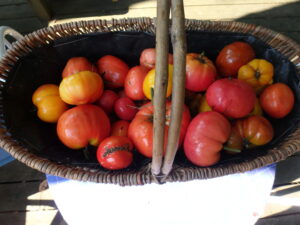
Heirloom tomatoes are often irregular in size and shape but they are tasty and you can save seeds for the next year
My grandfather saved seeds from his tomatoes and started plants indoors in the early spring. He was not growing hybrid tomatoes like those sold in the supermarket. Hybrid tomatoes are carefully bred by crossing specific varieties of tomatoes so that they will have special characteristics such as surviving long trips in trucks, having a shelf life almost as long as a tennis ball, or resisting certain diseases. But those are not suitable for seed saving – most of their seeds will produce mongrels, not the variety you grew.
My grandfather grew what we now call heirloom tomatoes: time-tested varieties that breed true from seed, generation after generation. Tomatoes that had been grown for many decades, seed shared with family and friends. Tomatoes so tasty that they were often eaten right in the garden, warm from the sun.
Examples of well-known heirloom tomatoes include Brandywine (often touted as the best flavored tomato in existence), Cherokee Purple, Mortgage Lifter, Amish Paste and Black Krim. But there are hundreds of varieties of heirloom tomatoes. Each unique and loved by someone. Many have now disappeared – once a variety is lost, it cannot be brought back unless someone has saved the seeds so they can be grown again.
All heirloom vegetables are what are called “open pollinated” meaning that they will produce the same variety every year. Of course, in a packet of seeds some will produce better fruits than others. There is variety, but all Brandywines will take about the same length of time to reach maturity and taste about the same.
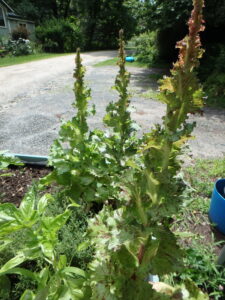
Once lettuce bolts like this it will flower and produce seeds you can save
If you would like to start saving seeds, read the seed packet or catalog and make sure what you buy is labeled open-pollinated or heirloom, not hybrid. At the end of the season, save some seeds and store them in a cool, dry, dark place, perhaps in a sealed jar in a refrigerator. Then start them the following spring.
I called Sylvia Davatz, the now-retired founder of Solstice Seeds in Hartland, Vermont to talk about saving seeds. Solstice Seeds only grows and sells seeds from heirloom varieties including some varieties from Europe.
She gave me lots of good advice, starting with the names of two good books on seed saving: The Seed Garden by Lee Buttala and Sharyn Seigel, and The Manual of Seed Saving by Andrea Heistinger. She recommends getting both books if you are going to be serious about saving seeds as even among experts there are differences of opinion. These books will tell you all you need to know.
One of the reasons for having good books about seed saving is that they will advise you about such things as isolation distances to prevent mixing genetic material by pollinators or wind.
I asked Sylvia what vegetable species are the easiest to save. She said tomatoes, lettuce, beans and peas are all easy. They are self-pollinated and annuals. No insects are needed, and seeds are ready by the end of their season.

The Seed Garden
Vine crops like squash, pumpkins and cucumbers are insect pollinated and more difficult. If you’ve ever let a “pumpkin” grow in your compost pile from last year’s crop, you know that sometimes you get weird things due to cross pollination – a pumpkin crossed with a summer squash by a bee, for example, may not be something you want to eat.
Most difficult in our climate are the biennials, things like carrots, beets, parsnips and parsley. These plants have to be kept alive all winter so they can flower and set seeds in their second year. You can dig up carrots and store them in soil in a bucket in a cold basement and re-plant them in the spring. But carrots, Sylvia explained to me, bloom about the same time as Queen Anne’s lace, a biennial wild flower/weed that can be pollinated by them – which would not produce the carrots you want.
Sylvia pointed out that in the not-to-distant past, seed saving was the norm. Farmers and gardeners saved seeds from their best plants, knew how to do so, and how to store them. She explained that the seeds you save will usually be of better quality than seeds from a packet. They will have more vigor and a longer life span.
A good source for heirloom seeds is The Seed Savers Exchange. It has, since 1975, collected and stored seeds from gardeners and farmers. You can join their non-profit or just buy some seeds or books from them. According to their website, they now store some 20,000 varieties in their collection, although at any given time only a fraction of them are actually for sale.
So think about saving seeds this year – even if only a few from your favorite heirloom tomatoes. And go to www.solsticeseeds.org to see a wonderful 8 minute video of Sylvia Davatz explaining all the importance and benefits of seed saving.
Henry is the author of 4 gardening books and a lifetime organic gardener. He lives in Cornish Flat, NH. Reach him by e-mail at henry.homeyer@comcast.net
Planning a Garden in the Lawn
Posted on Tuesday, January 24, 2023 · Leave a Comment
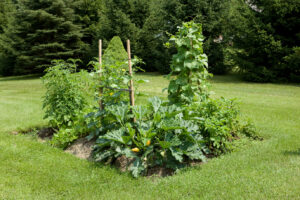
A 10 by 12 ft garden in August
This is a good time to make plans. If you are willing to spend just 15 minutes a day, every day, from spring to fall you can create an edible showcase for beauty: the splendid look of ripe red tomatoes, multi-colored Swiss chard, or glossy green peppers. It’s not nearly as difficult as you think. And unlike maintaining a lawn, you get to eat the results of your labor. Here’s what you need to do:
To grow good vegetables you need sunshine, at least 6 hours a day – and preferably more. For most people, the sunniest part of the yard is in the middle of the lawn. A well maintained vegetable garden can be as gorgeous as a flower garden. And if you like flowers, you can plant some of those in your vegetable garden, too.
Don’t bite off more than you can chew – or weed. A nice lawn garden can be just 10 feet across and 12 feet long. Properly maintained, it will provide you with fresh veggies much of the summer.
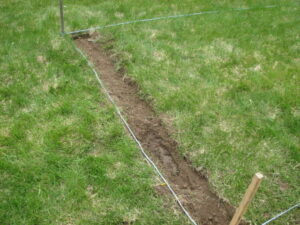
Lay out the garden with string and remove the grass
Using string and stakes define the borders of the garden and pry out the sod after cutting it into 1-foot squares with an edging tool or a spade. Use the sod to start a compost pile.
Start early enough in the season – say the first of May – so you can work just 15 or 20 minutes a day for a week or more to get all the grass out. That way you get in the habit of spending time in the garden, but don’t develop blisters or an aching back. Gardening should be fun, not hard work. Still, it can give you a workout without going to the gym.
Your lawn garden will have two raised beds separated by a walkway. Once you have removed the sod, you can just mound up the soil to form beds about 30 inches wide with a walkway up the middle and a 6-inch space between the lawn and the beds all the way around the garden. To do this, (after removing the sod) loosen the soil with a garden fork, shake out the soil and then rake the soil from the perimeter and the walkway onto the beds.
Then spread out 5 bags of composted cow manure on each bed (each bag is usually labeled 30 quarts), and work it into the loose soil with your garden fork or favorite hand tool.
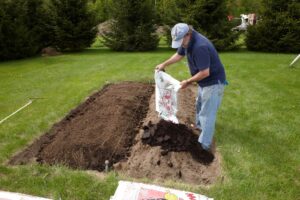
Adding composted manure enriches the soil
Alternatively, you can build wood-sided beds using ordinary 6 or 8-inch wide planks. For more years of service, 2 inch thick lumber is even better. Gardener’s Supply (www.Gardeners.com) sells a variety of brackets for building raised beds, and I suppose others do, too.
If you build wood-sided beds you will have to buy more filler than if using mounded beds. Most garden centers sell top soil and compost by the tractor scoop, which is usually two thirds of a cubic yard of material. They’ll dump right into the back of your pickup truck, or even deliver (for a price). I recommend a mix of topsoil and compost, a 50-50 mix.
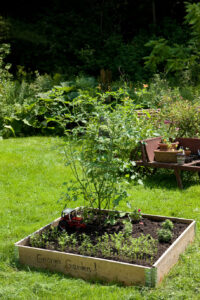
A small raised bed is great for a child
If you make wood-sided beds you can place them right on the lawn without removing the sod, which saves a lot of labor. Just scalp the grass with the lawnmower and put a thick layer of newspapers over the lawn, then fill the box. Long carrots might hit the bottom the first year, but most other plants won’t be bothered.
What to plant? Make a list of the veggies you like best and that taste best freshly picked. If you plant tomatoes, dedicate at least 24 inches of a row to each plant. And buy those wire cages for your tomatoes, so they won’t flop over and shade out your carrots or broccoli nearby.
I like to plant lettuce seedlings all around the tomatoes at the beginning of the season while the tomatoes are still small. By the time the plants get big, the lettuce will have been harvested and eaten. Run your rows north-south, and plant tomatoes (or any tall plants) on the north end of the garden so they will shade other plants less. Buy some bagged organic fertilizer and stir some in at planting time.
Oh, and about those weeds: the easiest way to prevent a problem is to mulch. Put down 6 sheets of newspaper and cover it with straw, mulch hay or last fall’s leaves. This will keep the soil dark, turning off the switch that weed seeds have to tell them when to germinate. Mulch also holds in the moisture during dry times. But when a few weeds do turn up – and they will – be sure to pull them before they get big and make more seeds. That’s preventive maintenance.
Gardening is said to be a middle aged sport. After all, what parent of three toddlers has time to weed? But if you wish to reduce your food costs and feed your family well, a garden is great. And done this way, you can maintain it in 15 minutes a day. I promise. Just keep at it daily, and you’ll be surprised and delighted at how good your garden looks, and how much food you can grow – right in the middle of the lawn!
Henry is a UNH Master
Gardener and the author of 4
gardening books. Send mail to him at PO Box 364, Cornish Flat, NH 03746 or e-mail him at
henry.homeyer@comcaset.net.
The Spring Flower Shows Are Back!
Posted on Tuesday, January 17, 2023 · Leave a Comment
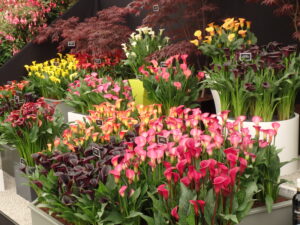
Calla lilies at the Chelsea Flower Show in London
The spring flower shows are always a contrast to the cold, icy days of winter. Bright flowers, garden paraphernalia and numerous workshops make these events fun – both for beginner and expert. Here is this year’s offerings, starting with the first ones in February and going on until May.
The first show of the season in a specialty show: orchids. The NH Orchid Society is holding its annual get-together February 10 to 12 at the Courtyard Marriott in Nashua, NH. This is THE show for orchid lovers. There will be vendors of orchids from Ecuador, Taiwan and the USA. Members of the Society will bring their orchids to compete and to strut their stuff. Admission is just $10 or $8 for seniors.
Next up is the Connecticut Flower and Garden Show February 23 to 26. This is a mammoth show with over three acres of displays. As always, it is being held at the Connecticut Convention Center in Hartford, CT. Tickets are $20 at the door, or $17 in advance. Kids 5 to 12 are $5.
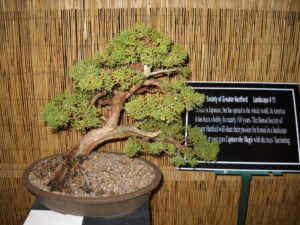
Bonsai on display at a past Connecticut Flower Show
One of the greatest things about this show are the educational seminars. Here are a few workshops that interest me: “Good Bug, Bad Bug, Benign Bug”. This is great for anyone who tends to squish any bug in the garden – even though most are not a problem. I assume there will be slides of insects we should recognize, but probably don’t. Then there is one on organic lawn care, another called, “Shady Characters”. I know garden writer Ellen Ecker Ogden of Vermont will do a nice slide presentation and talk about Kitchen Garden Design and how to make your veggies look artful. She always does.
One of my favorite shows is always the Vermont Flower Show. It will take place this year March 3 to 5 at the Champlain Valley Expo Center in Essex Junction, VT. The theme this year is “Out of Hibernation! Spring Comes to the 100-Acre Wood”, a tribute to Winnie the Pooh.
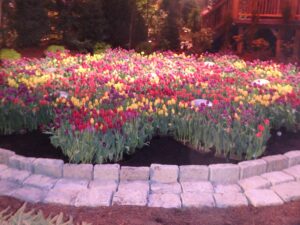
Tulips at the Vermont Flower Show
The main garden display is always a collaborative effort by members of the Vermont Nursery and Landscape Association. For three and a half days members of VNLA will work together to create a 15,000 square foot display using their own and donated materials. Other shows tend to have displays by professionals that are competing with each other, but not in Vermont – they work together.
There will be over 100 vendors and 35 workshops to attend over the three days of the event. In the past I have purchased seeds, seed potatoes, bulbs, books and garden tools. Tickets are $25 or $20 for seniors. Kids are $7.
The Vermont show is a child-friendly event with a craft room open all day. Go online to see the schedule of events for kids – there will be a magician, marionettes and music. Be sure to attend this year – it only occurs every other year.
A bit farther afield there is the Philadelphia Flower Show. Last year they held it outdoors in May due to Covid concerns, but this year they are back inside the Pennsylvania Convention Center in downtown Philly March 4 to 12.
According to their publicity, “The PHS Philadelphia Flower Show is both the nation’s largest and the world’s longest-running horticultural event, featuring stunning displays by premier floral and landscape designers from around the globe. Started in 1829 by the Pennsylvania Horticultural Society, the Show introduces diverse and sustainable plant varieties and garden and design concepts. In addition to acres of garden displays, the Flower Show hosts esteemed competitions in horticulture and artistic floral arranging, gardening presentations and demonstrations, and special events.”
I’ve been to the Philly show a couple of times and I am always amazed by the sheer size and diversity of the displays, vendors and workshops. It is best to go mid-week when crowds are smaller, and take two days, if you can, to see it all. Tickets are $43.50 for adults and $20 for kids.
A show I have yet to attend is the Capital Region Flower and Garden Show in Troy, NY which will be held again this year at Hudson Valley Community College in Troy from March 24 to 26. According to their website, there will be 160 vendors and exhibitors and 8 to 10 workshops each day.
Then in May there is the New Hampshire Farm, Garden and Forest Expo being held this year at the Deerfield, NH Fairgrounds on May 5 and 6. It is now in its 40th year and is the least commercial of all the shows. It is focused on sharing information.
Finally on May 23 to 27 there is the Chelsea Flower Show of the Royal Horticultural Society (RHS) in London, England. I’ve been, and the trip was well worth it. It’s held outdoors and is truly wonderful.

Opening day a the Chelsea Flower Show can be crowded
If you plan to go to Chelsea, join the RHS to get better access times and pricing. Members get a discount of over $10 per day, but prices still range from $89 to $46 depending on the day of the week. British women tend to dress up for this show and wear big colorful hats. The first 2 days are for members only, so it should be a bit less crowded.
The spring flower shows are fun – and we deserve that after a long New England winter.
Henry is a UNH Master
Gardener and the author of 4
gardening books. Reach him at henry.homeyer @
comcast.net.
Growing Food for Taste and Flavor
Posted on Thursday, January 12, 2023 · Leave a Comment
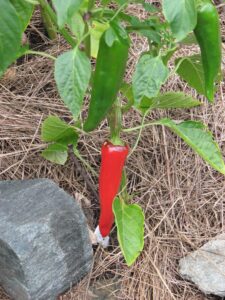
My favorite pepper is the Espelette, a hot pepper I first tasted in France
We gardeners love our home grown vegetables. As John Denver sang long ago, “Only two things that money can’t buy and that’s true love and homegrown tomatoes.” And why do they taste so good? We can grow tomatoes that don’t have to conform to commercial requirements of size, shape, color and transportability. Our soils generally are rich in compost or manure and host a wide range of minerals and micro-organisms that enhance the flavors of our vegetables. And of course, we eat them fresh from the garden.
We can taste five flavors: sweet, sour, salty, bitter and umami. These flavors were important to our evolution as they told early humans what was safe to eat – and what to avoid. The fifth flavor was not named until the last century: umami signals available protein in meat, eggs, milk, and beans. It is not as easily described or identified as the other four, but it is sometimes described as the flavor of contentment. We need protein, and feel good when we eat it.
So how can we recognize the complex flavors of a good stew, and aged cheese or a bowl of exquisite ice cream? Our noses can recognize many thousands of distinct scents, and our noses and tongues work together to create tastes. Good chefs recognize this, and many farmers do, too. I recently read a book that contains interviews with fine organic farmers who treasure their soil and what it imparts to the scents and flavors of the food they grow.
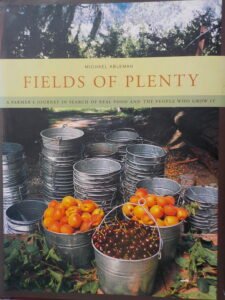
This book recounts a wonderful journey across America visiting organic farmers
That book by Michael Abelman is called “Fields of Plenty: A Farmer’s Journey in Search of Real Food and the People Who Grow It”. Abelman, an experienced author and organic farmer in British Columbia, spent three months traveling around the States in a 15-year old VW van. He went with his 23-year old son back in 2004. They camped out, ate local food and met with organic farmers, some of whom were growing food for the best restaurants in America.
There is much to love about this book: Abelman is a skilled writer and story teller, he is a talented photographer, and he is adventurous and inquisitive. Not only that, he included recipes from many of the farmers, and they all sound delicious – and mostly vegetarian.
Each of these farmers he wrote about had a unique approach to farming. One let weeds grow rampant. Another had fields that were weed free and managed with “precision, control, formal science and discovery.” But all ate their own food, fresh from the field – or in the field. And each interview gave me something to think about, and perhaps to apply to my garden.
One of the most startling interviews was with Bob Cannard in Sonoma, California. Raised on a farm, Bob went to agriculture school but dropped out and started his own farm. When starting out, Bob grappled with this question: Why are natural places naturally healthy, while the fields and orchards of commercial agriculture are a continual battleground with weeds, insects and diseases?
His approach to farming was to try to mimic nature – weeds and all. He believed that plants that struggle to survive would develop more complex flavors – a belief later adopted by some wine makers. He believed that a monoculture – acres of the same crop – encouraged insect pests to arrive and necessitate insecticides. He succeeded as a farmer, selling vegetables to Chez Panisse and other high-end restaurants in San Francisco.
I was fascinated to read the section on Strafford Organic Creamery in Vermont. Earl Ransom has a small herd of Guernsey cows and bottles their milk in glass bottles and makes fabulous ice cream, which I know and love. Ransom believes that he gets wonderful flavors by letting his cows graze in pastures with a variety of grasses, wildflowers and weeds. Diversity in the field creates better milk, he says, and the fat in milk absorbs flavor.
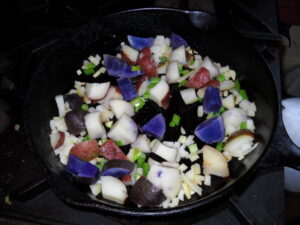
I grow and eat potatoes of several colors
The book provides the names of many varieties of vegetables that are exceptional. Organic farmers Gene and Eileen Thiel of Joseph, Oregon specialize in potatoes, and particularly likes LaRatte, Yagana and Sante. Sante, he said, is like a Yukon Gold, but bigger. Yukon Gold also got high marks, as did Ranger Russets and Yellow Finn. He avoids losing his crop to blights, in part, by growing lots of different kinds of potatoes – as did the Incas, where potatoes came from. Of course there is no guarantee that a potato that does well in Oregon will do well for you.
Abelman, a farmer for decades mentions some of his own favorite vegetable varieties. For sweet peppers he likes Ariane, Red Lipstick (I want to grow it, if just for that name) and Corno di Toro. Then there is the Charentais melon, about which he waxes poetic.
Of beans, some of the varieties mentioned as excellent include Valentine and Sophia flageolet shell beans, Maine Yellow Eye, Vermont Cranberry and Red Streaked Borllotto. According to the book, thin-skinned dry beans are easier on the digestive system: “the skins harbor the chemistry that causes digestive problems.”
It’s time for all of us to be studying seed catalogs and seed websites to pick the vegetables we’ll grow this year. I’ll be referring to Abelman’s book for new varieties, but also going back to my old favorites.
Henry is a lifelong organic gardener and the author of four gardening books. Reach him by e-mail at
henry.homeyer@comcast.net or by regular mail at PO Box 364, Cornish Flat, NH 03746.








































